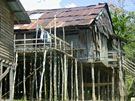Diving:
The tropical waters off both Peninsular
Malaysia and Borneo offer some of the world's
best scuba diving. This is a place endowed
with some of the sport's best possibilities:
you can dive with whale sharks, hover around
immense coral gardens and walls, or dive on
ominous and hulking WWII shipwrecks. In many
places, you can get 100 + feet of visibility.
Also, the country has become increasingly
aware of the biological and economic
importance of its marine heritage, and each
year brings better access to and protection
for the unique marine life. Because of the
hundreds of islands, there are many dive
options. Visit the dive pages to learn more
about Malaysia's diving options.
Shopping:
Next to activities like spelunking and jungle
trekking, "shopping" may sound a bit tame, but
make no mistake: exploring Malaysia's outdoor
markets is pure adventure (and of course you
can take home whatever you hunt - or bargain -
down). The variety of bargain items you can
find in the major markets is endless, ranging
from quality electronics to blowguns to
traditional arts and crafts. Currently, the
dollar goes a long way in Malaysia, so if
you're serious about shopping you might
consider bringing an extra bag along.
Visit the rain forest:
This is usually high on the list for anyone
planning a trip to Malaysia, and it should be:
the Malaysian rain forest is unique in the
world, the oldest on the planet. A trip to one
of the national parks, where you can take
guided jungle treks both day and night, can be
a profound experience. Nature has been
infinitely inventive with life here, producing
the world's largest flower, fantastically
adapted insects and mammals, and trees that
will make you gawk at their size. How
thoroughly you experience it is up to you:
most parks have resort-like headquarters where
you can stay in comfort, or you can opt for a
hard-core, guided trek deep into the jungle
interior (which will of course require you to
be in shape!).
 Visit
a longhouse: Visit
a longhouse:
Along the rivers of Sarawak and Sabah are some
very unique native communities where people
live in structures called longhouses, which
are really entire villages housed under a
single long roof. They live off small crops
and the bounty of the rain forest, and their
communality and generosity might best be
summed up by one simple fact: anyone is
welcome to stay for free for as long as they
like (though it is recommended that you bring
some small gifts, such as a candy for the
kids). Most visitors come with a native guide
who can also take you on a jungle walk and
translate for you. Some longhouses have
special "guest longhouses" adjacent for
visitors, others host guests inside the main
longhouse itself.
Spelunking:
Nature has been almost as generous to
Malaysia regarding its caves as it has with
the rain forest. Both the world's largest
single cave chamber, and the longest cave
passage in Southeast Asia can be found in
Sarawak's extraordinary Gunung Mulu National
Park. In fact, almost every national park in
Malaysia has a significant limestone cave
system, and many of them offer guided tours,
with varying levels of penetration.
Dining Out:
Because of its myriad cultural influences,
Malaysia is a country renown for its creative,
complex, and lovingly prepared original
cuisine. Food is taken very seriously here,
from the five-star restaurants right down to
the hawker's booths. Sauces tend to be highly
developed, often incorporating local fruits
and spices, and the seafood dishes are what
you'd expect from a country almost entirely
surrounded by ocean. To get a good overview of
what's out there, check out the cuisine
section.
|